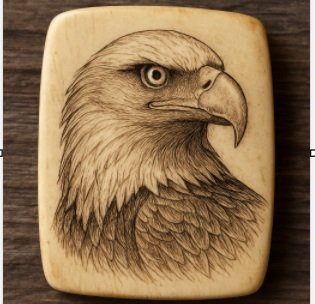Scrimshaw — the art of engraving intricate designs on ivory, bone, or similar materials — dates back to whalers of the 18th century who etched seafaring scenes onto whale teeth. Today, with modern technology like the xTool F1 laser engraver, artists can create detailed, authentic-looking scrimshaw with remarkable precision. Whether you’re working with mammoth ivory, bone, or synthetic materials, the xTool F1 opens up new possibilities for both traditionalists and contemporary artisans.
In this article, we'll explore how to use the xTool F1 for scrimshaw, the best materials to choose, techniques for achieving an authentic look, and important safety tips to keep in mind.
Why the xTool F1 is Ideal for Scrimshaw
The xTool F1 is a portable, high-speed laser engraver featuring both an infrared (1064nm) and diode (455nm) laser source. This dual-laser system allows you to engrave on a wide range of materials — from plastics and wood to metals and, importantly, organic materials like ivory substitutes, bone, and real mammoth ivory.
Key advantages of using the xTool F1 for scrimshaw include:
-
Precision: The F1 can engrave with pinpoint accuracy, allowing for the fine line work and delicate shading scrimshaw is famous for.
-
Speed: It can engrave small detailed scenes quickly without sacrificing detail.
-
Portability: The compact design lets you take it to art shows, workshops, or exhibitions.
-
Material Flexibility: With its infrared laser, the F1 can mark on hard, smooth surfaces like bone or mammoth ivory with minimal surface damage.
-
Software Control: Using xTool Creative Space or Lightburn, you can design your artwork digitally and translate it into beautifully etched pieces.
Materials for Laser Scrimshaw
If you want to create authentic-looking scrimshaw with the xTool F1, your material selection matters greatly. Good options include:
-
Mammoth Ivory: Fossilized ivory from extinct mammoths, legally available in many states (but not California, New Jersey, or New York).
-
Bone Blanks: Readily available and cost-effective, often from cattle or camel bone.
-
Ivory Alternatives: Such as Micarta ivory, Elforyn, or resin composites that mimic the appearance of real ivory.
-
Tagua Nuts ("Vegetable Ivory"): Eco-friendly option that laser engraves beautifully.
-
Synthetic Materials: Some artists use white acrylics or special laser-friendly polymers.
Tip: Always clean and prepare your surface before engraving. Dirt, oils, or inconsistencies can distort your laser's path.
How to Create Scrimshaw-Style Engravings with xTool F1
Here’s a basic workflow for creating scrimshaw art with your xTool F1:
-
Design Your Artwork:
-
Create a high-contrast black-and-white image in a graphics program like Adobe Illustrator, Inkscape, or even xTool Creative Space.
-
Focus on clean lines — traditional scrimshaw is often line art with cross-hatching for shading.
-
-
Prepare Your Material:
-
Lightly sand and polish your ivory, bone, or blank to ensure a smooth surface.
-
Secure it firmly in place on the engraver bed.
-
-
Set Up the Laser:
-
Use the infrared laser (1064nm) for organic surfaces like bone or ivory.
-
Set low power (around 10-20%) and high speed settings to mimic fine hand engraving without deep burning.
-
Do test burns first! Each material reacts differently.
-
-
Engrave:
-
Import your design and align it precisely.
-
Run the engraving pass.
-
Inspect after the first pass; light "scrimshaw" often benefits from double passes at low power rather than one heavy pass.
-
-
Enhance the Lines (Optional):
-
To achieve the traditional scrimshaw effect, rub dark pigment (India ink, oil paint, or special scrimshaw ink) into the engraved lines, then gently wipe the surface clean.
-
The pigment will remain in the etched grooves, creating contrast.
-
-
Seal the Work:
-
For longevity, lightly seal the piece with a wax or clear acrylic to protect it from oils and moisture.
-
Tips for Authentic-Looking Laser Scrimshaw
-
Use Fine Line Art: Avoid heavy blocky designs — true scrimshaw is all about fine, flowing lines.
-
Mimic Hand Strokes: Randomize your hatch patterns slightly to avoid a "mechanical" look.
-
Control Depth: True scrimshaw doesn’t require deep cuts — shallow, precise lines capture the essence.
-
Experiment with Textures: You can simulate stippling and cross-hatching using variable dot patterns in your artwork.
Safety Considerations
When using the xTool F1 or any laser to engrave organic materials:
-
Ventilation is critical: Engraving bone or ivory produces fine particulate smoke that should not be inhaled.
-
Wear a mask if needed if you’re working in a poorly ventilated area.
-
Monitor the engraving closely: Organic materials can char or ignite if the laser sits too long.
-
Avoid burning old, brittle materials: Fossil ivory can sometimes have cracks; approach delicate materials with caution.
Always follow the xTool F1’s safety guidelines, including using the built-in protective shields and fume extraction if possible.
Conclusion
The xTool F1 laser engraver brings the ancient art of scrimshaw into the 21st century. With its fine detail capability, material versatility, and portable size, it's an excellent tool for artists wanting to recreate the beauty of hand-carved scrimshaw with modern precision. Whether working on mammoth ivory, bone, or ethical alternatives, you can craft stunning pieces that honor this time-honored maritime tradition — while embracing the power of today’s technology.
Happy engraving!

